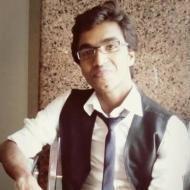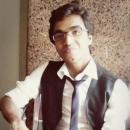
Chunabhatti, Mumbai, India - 400022.
Details verified of Umakant Jaiswar✕
 Identity
Identity
 Education
Education
Know how UrbanPro verifies Tutor details
Identity is verified based on matching the details uploaded by the Tutor with government databases.
English
Marathi
Hindi
![]() Mumbai Educational Trust (MET) Pursuing
Mumbai Educational Trust (MET) Pursuing
Diploma in pharmacy
Chunabhatti, Mumbai, India - 400022
![]() Phone Verified
Phone Verified
Report this Profile
Is this listing inaccurate or duplicate? Any other problem?
Please tell us about the problem and we will fix it.
Class Location
![]() Online (video chat via skype, google hangout etc)
Online (video chat via skype, google hangout etc)
![]() Student's Home
Student's Home
![]() Tutor's Home
Tutor's Home
Years of Experience in Class 9 Tuition
1
Board
State
CBSE Subjects taught
Hindi
Taught in School or College
No
State Syllabus Subjects taught
Science, English, Mathematics, Social Science, Hindi, EVS
Class Location
![]() Online (video chat via skype, google hangout etc)
Online (video chat via skype, google hangout etc)
![]() Student's Home
Student's Home
![]() Tutor's Home
Tutor's Home
Years of Experience in Class 10 Tuition
1
Board
State
CBSE Subjects taught
Hindi
Taught in School or College
No
State Syllabus Subjects taught
Science, English, Mathematics, Social Science, Hindi, EVS
Class Location
![]() Online (video chat via skype, google hangout etc)
Online (video chat via skype, google hangout etc)
![]() Student's Home
Student's Home
![]() Tutor's Home
Tutor's Home
Years of Experience in Hindi Language Classes
1
Profession
Student
Awards and Recognition
No
Mother Tongue
Yes
Languages apart from english in which classes are conducted
Yes
Class Location
![]() Online (video chat via skype, google hangout etc)
Online (video chat via skype, google hangout etc)
![]() Student's Home
Student's Home
![]() Tutor's Home
Tutor's Home
Years of Experience in Class I-V Tuition
2
Board
State
Taught in School or College
No
State Syllabus Subjects taught
English, Science, EVS, Mathematics, Hindi, Social Science
1. Which school boards of Class 10 do you teach for?
State
2. Do you have any prior teaching experience?
No
3. Which classes do you teach?
I teach Class 10 Tuition, Class 9 Tuition, Class I-V Tuition, Class VI-VIII Tuition and Hindi Language Classes.
4. Do you provide a demo class?
Yes, I provide a free demo class.
5. How many years of experience do you have?
I have been teaching for 1 year.
Answered on 17/12/2016 Learn Tuition Fee
Answered on 17/07/2016 Learn Tuition/Class VI-VIII Tuition
Answered on 17/07/2016 Learn Tuition/Class VI-VIII Tuition
Answered on 17/07/2016 Learn Tuition/Class VI-VIII Tuition
Answered on 17/07/2016 Learn Tuition/Class VI-VIII Tuition
Class Location
![]() Online (video chat via skype, google hangout etc)
Online (video chat via skype, google hangout etc)
![]() Student's Home
Student's Home
![]() Tutor's Home
Tutor's Home
Years of Experience in Class 9 Tuition
1
Board
State
CBSE Subjects taught
Hindi
Taught in School or College
No
State Syllabus Subjects taught
Science, English, Mathematics, Social Science, Hindi, EVS
Class Location
![]() Online (video chat via skype, google hangout etc)
Online (video chat via skype, google hangout etc)
![]() Student's Home
Student's Home
![]() Tutor's Home
Tutor's Home
Years of Experience in Class 10 Tuition
1
Board
State
CBSE Subjects taught
Hindi
Taught in School or College
No
State Syllabus Subjects taught
Science, English, Mathematics, Social Science, Hindi, EVS
Class Location
![]() Online (video chat via skype, google hangout etc)
Online (video chat via skype, google hangout etc)
![]() Student's Home
Student's Home
![]() Tutor's Home
Tutor's Home
Years of Experience in Hindi Language Classes
1
Profession
Student
Awards and Recognition
No
Mother Tongue
Yes
Languages apart from english in which classes are conducted
Yes
Class Location
![]() Online (video chat via skype, google hangout etc)
Online (video chat via skype, google hangout etc)
![]() Student's Home
Student's Home
![]() Tutor's Home
Tutor's Home
Years of Experience in Class I-V Tuition
2
Board
State
Taught in School or College
No
State Syllabus Subjects taught
English, Science, EVS, Mathematics, Hindi, Social Science
Answered on 17/12/2016 Learn Tuition Fee
Answered on 17/07/2016 Learn Tuition/Class VI-VIII Tuition
Answered on 17/07/2016 Learn Tuition/Class VI-VIII Tuition
Answered on 17/07/2016 Learn Tuition/Class VI-VIII Tuition
Answered on 17/07/2016 Learn Tuition/Class VI-VIII Tuition

Share this Profile
Also have a look at
Reply to 's review
Enter your reply*
Your reply has been successfully submitted.
Certified
The Certified badge indicates that the Tutor has received good amount of positive feedback from Students.